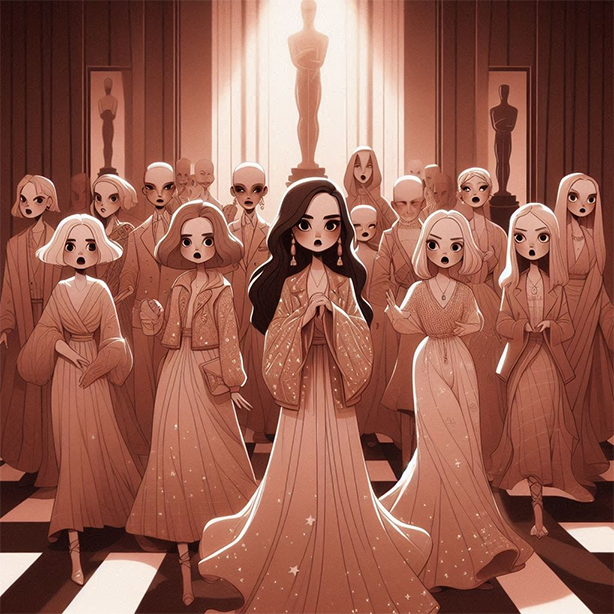Indian cinema has long been celebrated for its vibrant storytelling, diverse culture, and ability to transcend geographical boundaries. The selection of “Laapataa Ladies” as India’s official entry to the Oscars 2025 is yet another testament to the power of Indian films to evoke global resonance. Directed by Kiran Rao, “Laapataa Ladies” is an extraordinary blend of drama, comedy, and social commentary that has captured the hearts of audiences worldwide. Its recognition on the prestigious stage of the Academy Awards signifies not only the quality of the film but also the evolution of Indian cinema as a key player in global cinema.
This article explores the significance of “Laapataa Ladies” being chosen as India’s submission for the Best International Feature Film at the 2025 Academy Awards, examining the film’s narrative, cultural relevance, cinematic excellence, and what this means for Indian cinema on the global stage.
A Synopsis of “Laapataa Ladies”
Set in rural India during the 1990s, “Laapataa Ladies” (translated as “Missing Ladies”) tells the story of two women, Phool and Lajjo, who get lost while traveling on a train after their wedding. In a society where women’s identities are often tied to marriage and familial roles, their disappearance unleashes a cascade of events that leads to an exploration of freedom, identity, and societal expectations.
As the two women navigate their way through a patriarchal society, they are met with various challenges that force them to confront their own desires and independence. Despite the serious themes, the film uses humor and wit to tell a story that is as heartwarming as it is thought-provoking. With a strong script, stellar performances, and Rao’s deft direction, “Laapataa Ladies” offers a narrative that resonates on multiple levels—an essential feature of films that tend to perform well in global circuits.
Kiran Rao’s Vision and Directorial Brilliance
Kiran Rao, known for her nuanced storytelling, has previously made waves with her debut film “Dhobi Ghat” (2010), which earned her critical acclaim. With “Laapataa Ladies,” she continues to break new ground, taking a simple premise and layering it with complex themes about gender, agency, and the Indian social fabric. Rao’s meticulous attention to detail, coupled with her ability to infuse humor in poignant moments, makes “Laapataa Ladies” a cinematic gem.
In the hands of a lesser director, the film could have easily fallen into predictable patterns or melodrama. However, Rao’s direction elevates the film to a space where comedy and tragedy intersect seamlessly. Her ability to portray a strong feminist narrative without being didactic makes the film accessible to a wide audience, both in India and internationally.
Kiran Rao’s directorial approach in “Laapataa Ladies” balances the line between being an entertaining piece of cinema and a commentary on the sociopolitical landscape of the time. The film’s visual storytelling, use of symbolism, and the manner in which Rao weaves in cultural context make it stand out in an era where films from India are gaining attention for their authentic voices and unique perspectives.
Strong Performances Elevating the Narrative
At the heart of “Laapataa Ladies” are its performances. The cast, led by Nitanshi Goel and Pratibha Ranta in the roles of Phool and Lajjo, deliver powerful and engaging performances that anchor the film. Goel and Ranta’s portrayal of two women navigating through the trials and tribulations of a male-dominated society is both compelling and heartfelt. Their chemistry and individual character arcs bring out the emotional depth of the story, ensuring that audiences remain invested in their journey.
Supporting performances by Ravi Kishan and other key cast members further enrich the film’s narrative, providing a strong ensemble that brings authenticity to the characters. Rao’s ability to extract such layered performances from her cast is a testament to her skill as a director. Each character, regardless of screen time, adds to the film’s rich tapestry of storytelling.
The Cultural Relevance of “Laapataa Ladies”
Indian cinema is often defined by its ability to reflect the social realities of its time, and “Laapataa Ladies” does just that. Set in the 1990s, the film captures a period in India where traditional values were being challenged by new socio-economic changes. The film’s backdrop allows for an exploration of how women’s roles were evolving during this time, and the narrative acts as a microcosm for larger discussions around gender equality and autonomy in India.
The themes of the film—women’s identity, empowerment, and freedom—are universal and timeless, making the film accessible to international audiences as well. While the setting and cultural nuances are distinctly Indian, the issues the film addresses are relatable to viewers around the world, contributing to its widespread appeal.
By juxtaposing humor with serious issues, “Laapataa Ladies” manages to convey powerful messages without being heavy-handed. The film’s lighthearted tone allows for reflection on deeper societal issues in a way that feels organic and approachable, ensuring that its core message is not lost in its entertainment value.
Oscar Recognition and the Global Stage
The selection of “Laapataa Ladies” as India’s official entry for the Best International Feature Film category at the 2025 Oscars is a significant achievement. The Academy Awards represent the pinnacle of international recognition for films, and being chosen as a contender places “Laapataa Ladies” among the best in global cinema.
In recent years, India has sent a variety of films to the Oscars, but few have managed to secure a nomination. With the growing interest in diverse cinematic voices, the Oscars are increasingly highlighting films that bring underrepresented stories to the forefront. “Laapataa Ladies” fits perfectly into this trend, offering a fresh perspective on Indian womanhood while maintaining a universally engaging storyline.
The film’s humor, combined with its poignant social commentary, has the potential to captivate the Academy’s voters, who are known to appreciate films that blend entertainment with substance. As the global landscape of cinema continues to evolve, with an increasing emphasis on authenticity and representation, “Laapataa Ladies” stands a strong chance of being embraced by international audiences and Academy members alike.
The Broader Implications for Indian Cinema
The recognition of “Laapataa Ladies” at the Oscars goes beyond the film itself—it marks a significant moment for Indian cinema as a whole. In recent years, Indian films have gained international attention, moving beyond the stereotypical “Bollywood” narrative of song and dance to explore more diverse and complex stories. The global film community is starting to recognize the depth and breadth of Indian cinema, from independent films to regional cinema.
Films like “Laapataa Ladies” represent a shift in Indian storytelling—one that embraces local narratives but has universal appeal. The success of such films on the global stage opens doors for more Indian filmmakers to tell authentic stories without conforming to Western cinematic expectations. Moreover, it paves the way for more nuanced portrayals of Indian society, moving away from the larger-than-life spectacle often associated with Indian cinema abroad.
For Indian filmmakers and audiences, the success of a film like “Laapataa Ladies” at the Oscars can inspire future projects that aim to strike a balance between commercial appeal and social relevance. It also reflects a growing appetite among global audiences for stories that are deeply rooted in culture but speak to universal human experiences.
A Cinematic Milestone
The journey of “Laapataa Ladies” to the Oscars 2025 is a story of triumph, not just for the filmmakers but for Indian cinema as a whole. Kiran Rao’s masterful direction, combined with stellar performances and a compelling narrative, has created a film that resonates across cultures and borders. Its recognition on a global stage like the Oscars is a testament to the power of Indian cinema to tell stories that matter, stories that entertain while also making us reflect on the society we live in.
Whether “Laapataa Ladies” ultimately brings home the coveted Oscar or not, its selection as India’s official entry already marks it as a significant milestone in the country’s cinematic history. It signals a bright future for Indian films on the global stage, where diverse voices and stories are celebrated. In many ways, the film embodies the essence of what makes cinema such a powerful medium—its ability to connect, inspire, and provoke thought, all while delivering an unforgettable experience.

